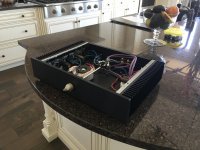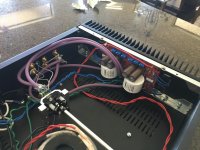BA-3 pre sounds amazing. However, only getting a max of 65mv across R3. Papa says 80mv as a start. Should I swap P3 for different value?
View attachment 689895
View attachment 689895
At this point, I still prefer my DCB1, it's j just a lot more revealing. Obviously, the BA-3 is a pre, and the DCB1 a buffer: apples and oranges comparison. In Bob Ross vernacular I would say the BA-3 is a Cadmium yellow hue: it's warm and soft, with a big presentation. This gives very unkind recordings a severe attitude adjustment.
The DCB1 is titanium white: focused, tight, revealing, but flat in presentation. Poorly
recorded / mixed tracks sound poor: Harmonics are simply whatever they are in the recording.
There in lies the problem with a buffer. It does a wonderful job of presenting the right load to each component, but sonically, you get what you get.
I've been playing with P3 and that is fun. Instead of using RTA, I'm just adjusting and listening. This has been a very fun experience and it's a great platform for other designs to go into this chassis: I have both good voltage and current swing for many other boards.
My current system:
Speakers: Martin Logan Montis
Amp: USSA-5
Source: Eastern Electric Minimax Supreme fed by Tidal/Roon
Cheers,
Greg
The DCB1 is titanium white: focused, tight, revealing, but flat in presentation. Poorly
recorded / mixed tracks sound poor: Harmonics are simply whatever they are in the recording.
There in lies the problem with a buffer. It does a wonderful job of presenting the right load to each component, but sonically, you get what you get.
I've been playing with P3 and that is fun. Instead of using RTA, I'm just adjusting and listening. This has been a very fun experience and it's a great platform for other designs to go into this chassis: I have both good voltage and current swing for many other boards.
My current system:
Speakers: Martin Logan Montis
Amp: USSA-5
Source: Eastern Electric Minimax Supreme fed by Tidal/Roon
Cheers,
Greg
I'm not always a fan of wretched excess, but hop-diggidy-dog, that case looks awesome!!!
I've always wanted to try the Salas LV shunt with this circuit, very cool!
Did you get it to bias properly?
Yeah, I used to put my projects in whatever hammond project box I had, but Modu stuff rocks!
Bias-wise, I'm still below what Papa wants as a starting point on the fets (~70mv max)
Salas shunts are a beauty and sonic-wise, they're killer. I just cut the hs brackets so that I could get them to fit. Its tidy and clean. Salas is

At this point, I still prefer my DCB1, it's j just a lot more revealing. Obviously, the BA-3 is a pre, and the DCB1 a buffer: apples and oranges comparison. In Bob Ross vernacular I would say the BA-3 is a Cadmium yellow hue: it's warm and soft, with a big presentation. This gives very unkind recordings a severe attitude adjustment.
The DCB1 is titanium white: focused, tight, revealing, but flat in presentation. Poorly
recorded / mixed tracks sound poor: Harmonics are simply whatever they are in the recording.
There in lies the problem with a buffer. It does a wonderful job of presenting the right load to each component, but sonically, you get what you get.
I've been playing with P3 and that is fun. Instead of using RTA, I'm just adjusting and listening. This has been a very fun experience and it's a great platform for other designs to go into this chassis: I have both good voltage and current swing for many other boards.
My current system:
Speakers: Martin Logan Montis
Amp: USSA-5
Source: Eastern Electric Minimax Supreme fed by Tidal/Roon
Cheers,
Greg
Agreed. The BA3 is ballsy big sound. Perfect for First Watt clones needing a touch more giddy up.
Russellc
I think I will go for the Fairchild output FETs…..so that will mean 1k for P1 and P2. For the input JFETs I have some LSK170 / LSJ74 but they are grade A.....so I assume they are not going to work…..they will never be able to deliver 8 mA bias. So I will probably buy some Toshibas at ebay in the right grade for the amp.
You can always add more resistance in series with the pot or use bigger pots to get the Jfets to bias properly. It makes no difference to the operation of the circuit or the sound.
Generally speaking, a Pass project is going to work properly with BL grade Jfets (B LSK), and 8mA being the center of the BL distribution curve, that's the target. However, most circuits will work just fine with anything in the BL range.
Where the stock value of the bias pot is seeming insufficient is because the Vgs of the specified Mosfets (Toshiba K2013/J313) is on average a volt or more lower than the IRF and the FQP. So you need more ohms pot to turn on the entire circuit and get the bias flowing to specification.
SO, get some BL Jfet and use a bigger pot.
Generally speaking, a Pass project is going to work properly with BL grade Jfets (B LSK), and 8mA being the center of the BL distribution curve, that's the target. However, most circuits will work just fine with anything in the BL range.
Where the stock value of the bias pot is seeming insufficient is because the Vgs of the specified Mosfets (Toshiba K2013/J313) is on average a volt or more lower than the IRF and the FQP. So you need more ohms pot to turn on the entire circuit and get the bias flowing to specification.
SO, get some BL Jfet and use a bigger pot.
I have not got the PCBs yet so only in a preparation phase. It is the plan to build the Korg Nutube fist and have the BA3 as an option. The P3 is a bit special.....I wonder if it is possible to get R and L channel adjusted identical without having equipment to see the waveform of the distorsion.....and then adjust L and R channel by "ear". I had an idea to mount chassis mount multiturn pots for P3 so they can be easy adjusted during operation. This will mean longer wires which is probably not good for the noise performance.
The P3 is a bit special.....I wonder if it is possible to get R and L channel adjusted identical without having equipment to see the waveform of the distortion.....and then adjust L and R channel by "ear".
Nope. Don't even bother trying. I know in the guide I alluded to it being possible, (and in retrospect saying that was incorrect) -- after building and adjusting quite a few projects with P3, you must be able to see what you are doing if you are wanting channel to channel symmetry.
Having the ability to properly adjust and getting the amplification spectra balanced in both channels is nothing short of amazing sonically. You'll be very impressed.
Do you have a computer? ARTA software and a USB audio interface such as a Focusrite Scarlet or Tascam is a superior solution to any analog distortion meter. (And an impressive amount more inexpensive...
ARTA Software
Focusrite Scarlett 2i2 | Sweetwater
TASCAM US-2X2 USB Audio Interface | Sweetwater
Last edited:
I hadn’t thought of doing it this way, but I might give this a shoT. How much do values fluctuate with temperature when you adjust p3? Is it trim-lid on-wait-measure like with the other pots?
How much will the dummy load matter? I have a 10k resistors I can use, but the pre goes into an f6 which is 100k iirc...
How much will the dummy load matter? I have a 10k resistors I can use, but the pre goes into an f6 which is 100k iirc...
- Home
- Amplifiers
- Pass Labs
- BA-3 As Preamp



